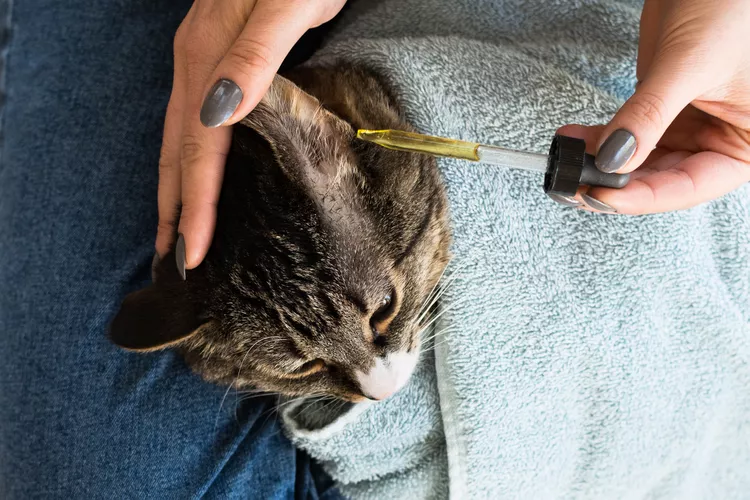How to Clean Cat Ears in 8 Steps

Depending on your cat’s grooming habits and environment, you may or may not need to clean its ears. Many cats are excellent at grooming themselves and rarely require ear care. Others are not as good with their grooming skills, are prone to dirty ears, or need routine cleanings to help prevent infection. Cleaning your cat's ears can be quick and easy; it just takes a little finessing to keep your cat calm so you can get the job done without any fuss.
How Do You Know if Your Cat's Ears Need Cleaning?
If you notice excessive wax, dirt, or other debris in and around your cat's ears, it is time for a cleaning. But you may also wonder if your cat has ear mites or just dirty ears. If you see your cat persistently scratching at its ears and the inner ears look like they're coated with black or brown coffee grounds, it could be mites.
Periodic cleanings and regular at-home checks can discover ear issues like mites sooner, allowing for timelier treatment options. If you suspect your cat may have an ear problem, call your veterinarian as soon as possible. Prompt treatment offers a better prognosis, reduces the potential for developing chronic problems and hearing loss, and can alleviate any discomfort your cat may be experiencing.
Before You Begin
For best results, begin by thoroughly cleaning the external portion of the ear. Using your fingers, or your cat's favorite comb, gently remove or detangle any matted fur from around the ear canal and ear flap. Mats of fur along the ear flap or surrounding skin and/or excessive hair within the ear canal can block the normal movement of debris and wax outward, possibly leading to infection.
In some cats, excess hair may need to be gently removed from inside the ear canal. This must be done carefully to avoid damaging the ear canal and to minimize discomfort to your pet. A professional groomer, veterinarian, or veterinary technician can help remove hair if needed as many cats need light sedation for this procedure.
What You Need
If you plan to clean your cat's ears yourself, you'll need a few common supplies:
- An ear cleaner made for cats
- A dropper or easy way to get a few drops of liquid into your cat's ear
- Cotton balls, gauze, or soft tissues
- A container of warm water
You will also probably want some treats on hand to keep your cat happy.
How to Clean a Cat's Ears
Cleaning your cat's ears is an easy task that takes about 10 minutes. Be sure to assemble the supplies and perform the cleaning in a space that's comfortable for you and your cat.
- Warm the ear cleaner to body temperature by placing the container in a warm (not hot) pan of water.
- Place the cat in your lap swaddled in a soft towel or blanket. If needed, you may need to wrap your cat in a burrito for handling.
- Put a drop or two of the cleaner into the round opening of the ear canal.
- Gently massage the base of the ear for at least a minute, to work the liquid around.
- Repeat steps 3 and 4 with the other ear. If it's easier, you could put the drops in both ears and then give your cat a double ear massage.
- Leave your cat alone for five minutes. Your pet cat will likely do a great deal of head shaking, which helps to dislodge dirt and debris from deep within the ear canal and move it into the outer surface.
- After five minutes, approach your cat (you may need to coax it out from hiding with treats) and use clean cotton balls to wipe away oil and dirt from inside and outside of the ear. If you want to swaddle your cat again, feel free, or try to accomplish this step without the towel or blanket.
- Give your cat another treat for being so good.
The same techniques can be used to administer ear medications, except for steps 1 and 7.
What to Look for During Cleaning
As your cat’s owner, you are the first line of defense in detecting anything abnormal with your cat’s behavior or health. When cleaning your cat's ears, keep an eye out for signs of problems including:
- Ear discharge (blood, pus, or other fluid)
- Odor around the ear
- Excess scratching, pawing, or rubbing of the ears
- Redness in the ear canal
- Sensitivity or pain around the ears
- Ear swelling
- Masses around the ear area
Preventing Problems During Ear Cleaning
You'll want your cat in a relaxed state during the cleaning, so don't push the cleaning if your cat feels stressed. Here are a few tips for ear-cleaning:
- Avoid using cotton swabs or other aggressive tools for cleaning, as these can cause serious injuries.
- Aim to clean both ears on the same day as it's best for the cat if both ears are cleaned at the same time, but don't push things if your cat is unhappy. You can always try the following day.
- Enlist a helper to assist with the task, but make sure it's someone your cat also adores.
If you suspect an issue with your cat's ears or see something that looks out of the ordinary, speak with your vet. Cleaning your cat's ears regularly will get you comfortable with what is normal and what is not.